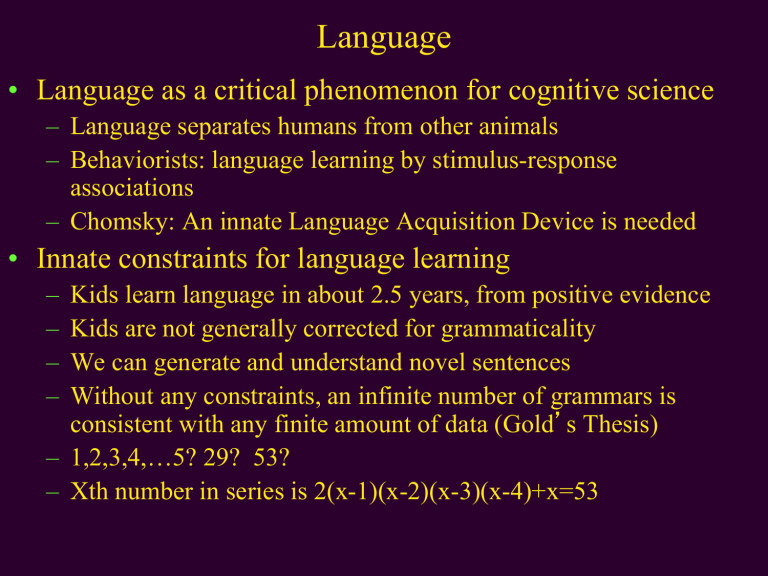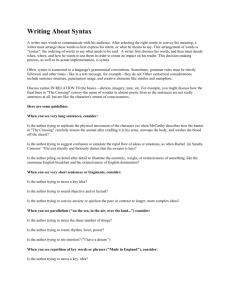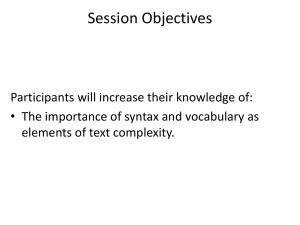Learning to Perceive While Perceiving to

Language
• Language as a critical phenomenon for cognitive science
– Language separates humans from other animals
– Behaviorists: language learning by stimulus-response associations
– Chomsky: An innate Language Acquisition Device is needed
• Innate constraints for language learning
– Kids learn language in about 2.5 years, from positive evidence
– Kids are not generally corrected for grammaticality
– We can generate and understand novel sentences
– Without any constraints, an infinite number of grammars is consistent with any finite amount of data (Gold ’ s Thesis)
– 1,2,3,4,…5? 29? 53?
– Xth number in series is 2(x-1)(x-2)(x-3)(x-4)+x=53
The Universal Language = what languages share
• Constraints on what we will consider as grammars
– Constraints are good - they allow learning to take place
• Word order of subject and object
– Subject-verb-object occurs
– Subject-object-verb occurs
– Object-subject-verb (almost) never occurs
• Word order of adjectives and nouns
– An adjective comes close to the noun it modifies
– La femme brave a frappe l ’ homme cruel
– [The woman brave hit the man cruel]
• Constraints help us to learn grammar rules quickly
Properties of Language
• Productivity/generativity
– People can produce novel utterances by putting together pieces
(words) in different arrangements
• Regularity
– Language has a systematic structure
– Only some structures are allowable
– Grammar gives rules for determining what is allowable
• Arbitrariness of symbols
– No inherent connection between symbol and meaning
– Violations
• Onomatopoiea - words that sound like what they mean: crack, buzz, bark
• Sound/meaning clusters: slip, slither, slide, sled, slope, slalom, slack, slimy
Sentence -> NP VP
Grammar
NP -> [article] [AP] noun
VP -> verb NP
AP -> adj [AP]
NP
Recursion: AP defined in terms of itself
S
VP
AP
NP verb noun
AP noun adj adj
Obsequious sequins sequester sanguine sequences
Syntax and Semantics
• Syntax
– The set of rules for putting together words and phrases to make sentences
• Semantics
– The meaning of the sentence
• Syntax without semantics
– Colorless green ideas sleep furiously
– Williams ’ syndrome. Very low IQ, preserved language
– Wernicke ’ s aphasia: flowing, meaningless speech
• Semantics without syntax
– If you wants now million dollars, “ give it to me ” say.
– Broca ’ s aphasia: halted, contentful speech
Syntax and semantics each promote understanding
• Three kinds of sentences in experiment
– Semantically meaningful and grammatical
– Semantically meaningless but grammatical
– Agrammatical
• Meaningful sentences are more likely to be comprehended than meaningless sentences
– Contribution of semantics
• Meaningless but grammatical sentences are more likely to be comprehended than agrammatical sentences
– Syntax provides its own constraints
• The more predictable and constrained a sentence is, the more comprehendible it is
– Redundancy helps understanding
A) A witness signed the official legal document.
B) Sloppy poetry leaves nuclear minutes.
C) Attracted wrapper the reverence private odorless.
A) A jeweler appraised the glittering diamond earrings.
B) Romantic ink follows wasted games.
C) Became lecture the bar deep wealthy.
A) A storm prevented the annual company picnic.
B) Total coffee describes eternal spots.
C) Played the formula club old controversial the.
A) A magazine exposed the shocking political corruption.
B) Healthy angry packages bloomed dangerously.
C) The built a was tamer fortune blaze by lazy.
Syntax influences perception
• Click migration
– Click travels to the boundary between phrases
As a direct result of their new invention ’ s influence the company
• Syntactic gaps seem larger than they really are
• Large gaps are more likely to be filled
Usually, syntax and semantics work together
• Finding meaning often requires finding syntactical parsing (interpretation)
– Sentences are often ambiguous because parsing is ambiguous
• Often, once syntax is clear, semantics is clear
S
NP VP
NP adj verb noun adj noun
Buffalo buffalo buffalo Buffalo buffalo teacher.
Other examples of ambiguity
In the window of an Oregon store:
Why go elsewhere and be cheated when you can come here?
In a New York restaurant:
Customers who consider our waitresses uncivil ought to see the manager.
In a Los Angeles dance hall:
Good clean dancing every night but Sunday.
In the offices of a loan company:
Ask about our plans for owning your home.
Does Language influence thought?
• The Sapir-Whorf hypothesis
– Linguistic relativism: people who speak different languages think abut world differently
– Eskimoes have 32 words for snow is NOT evidence for Sapir-Whorf
– Hopi combine form and substance together in words and similarity judgments
– Support from Brown and Lennenburg
• Determine “ highly codable colors ” and less codable colors based on consistency of color labels across people.
• Show 4 colors to subject
• Have subjects find colors in a pile
• Recognition for highly codable colors > recognition for less codable colors
• Rosch argues against Sapir-Whorf: universal color perception
– Dani are better at recognizing highly codable colors (in English) even though they only have terms for “ light ” and “ dark ”
– A universal progression of color terms
Orange
Pink
Black
White
Red
Yellow
Green
Blue Brown
Gray
Purple
Evidence in favor of linguistic relativism
• Berinmo and English differ in their ability to remember colors
– English and Berinmo have different color categories
– Task: Present a color, delay, show two possible colors, subjects ’ task is to choose the previously presented color
– English best at task when one color is “ blue ” and the other is “ green ”
– Berinmo best at task when one color is “ wor ” and the other is “ nol ”
• Chinese children count earlier than American children
– (In part) because Chinese numbers are more systematic
• Yucatac Mayan vs. English speakers (Lucy, 1992)
– Count nouns are countable objects: chairs, bananas, pens, trees
– Mass nouns are substances: jello, copper, mud, grease
– Mayans do not need to use plurals for most objects, treating them as mass nouns
– English: “ two chairs ” . Mayan: “ two chair ”
– Mayans ’ similarity judgments are more influenced by material (as appropriate for mass nouns), rather than shape (as appropriate for count nouns)
Wooden Fork Plastic Fork Plastic Knife
English Mayan
Davidoff, Davies, & Roberson (1999)
The gender marking for a word influences similarity ratings of pictures, and the features listed for a picture
Der Luffel (M): Spoon
Die Gabel (F): Fork
Das Messer (N) : Knife
M F
The modularity of word activation
• The “ speech is special ” movement
• Word priming is modularized: fast, efficient, doesn ’ t take everything into account
• Disambiguation of word meaning
– “ Rumor had it that, for years, the government building had been plagued with problems.
The man was not surprised when he found several spiders, roaches, and other bugs in the corner of the room.
”
– Are both “ insect bugs ” and “ listening device bugs ” activated when we read “ bugs ” ?
– Lexical decision task: Is the following string a word?
– Thirgs: “ No ” - non word
– Insect: “ Yes ” - word related to appropriate meaning
– Spy: “ Yes ” - word related to inappropriate meaning
– Book: “ Yes ” - word unrelated to either meaning
– Both “ Insect ” and “ Spy ” are faster than “ Book ” immediately after we read “ bugs ”
– After 750 msec, only “ Insect ” is primed.
– First priming is based on pure association, not on context or knowledge
• Other examples of priming


![The Word-MES Strategy[1]](http://s3.studylib.net/store/data/007764564_2-5130a463adfad55f224dc5c23cc6556c-300x300.png)





